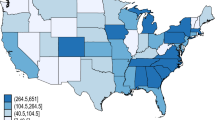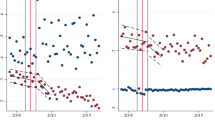Abstract
Models of the enforcement of environmental regulations regarding point source pollution suppose that the probability of inspection or audit is independent across facilities. However, there are a number of reasons why regulators may choose to inspect many sites in a particular geographic area at one time. If the probability a site is inspected also depends on its compliance behavior, the expected payoff from choosing to violate will depend upon the compliance decisions of neighboring sites, creating a game of strategic interdependence between firms. In this paper, we use a dataset of inspections at petroleum storage sites in Manitoba between 1981 and 1998 to consider to what extent inspections are spatially correlated and whether inspection probabilities are a function of the inspection and violation history of the site and its neighbors. Further, we examine to what extent firms take into account whether their neighbors have been previously found in violation in determining compliance.
Similar content being viewed by others
References
Alberini A. (2001) Environmental regulation and substitution between sources of pollution: An empirical analysis of Florida’s storage tanks. Journal of Regulatory Economics 19(1): 55–79
Betcher, R., Grove, G., & Pupp, C. (1995). Groundwater in Manitoba: Hydrogeology, quality concerns, management. Saskatoon: National Hydrogeology Research Contribution CS-93017.
Cohen, M. (2005). Empirical research on the deterrent effect of monitoring and enforcement. In Making law work: Environmental compliance and sustainable development, vol.1, (pp. 403–413). London: Cameron May
Craglia M., Haining R., Wiles P. (2000) A comparative evaluation of approaches to urban crime pattern analysis. Urban Studies 37(4): 711–729
Earnhart D. (2004) Regulatory factors shaping environmental performance at publicly-owned treatment plants. Journal of Environmental Economics and Management 48(1): 655–681
Eckert H. (2004) Inspections, warnings, and compliance: The case of petroleum storage regulation. Journal of Environmental Economics and Management 47: 232–259
Franckx L. (2002) The use of ambient inspections in environmental monitoring and enforcement when the inspection agency cannot commit itself to announced inspection probabilities. Journal of Environmental Economics and Management 43: 71–92
Franckx L. (2004) Marginal deterrence through ambient environmental inspections. Scottish Journal of Political Economy 51: 507–527
Government of Manitoba. (1972). The Clean Environment Act, S.M. C130.
Government of Manitoba. (1976). Storage and handling of gasoline and associated products M.R. 148/76. The Manitoba Gazette, 105(29).
Government of Manitoba. (1980). Storage and handling of gasoline and associated products M.R. 156/80. The Manitoba Gazette, 109(37).
Government of Manitoba. (1987). The Environment Act, C.C.S.M. E125.
Government of Manitoba. (1988). Storage and handling of gasoline and associated products M.R. 97/88. The Manitoba Gazette, 117(8).
Gray W., Deily M. (1996) Compliance and enforcement: Air pollution regulation in the American steel industry. Journal of Environmental Economics and Management 31: 96–111
Griffith D., Amrhein C. (1991) Statistical Analysis for Geographers. Prentice-Hall, Inc., New Jersey
Harford J. (1991) Measurement error and state-dependent pollution control enforcement. Journal of Environmental Economics and Management 21(1): 67–81
Harford J., Harrington W. (1991) A reconsideration of enforcement leverage when penalties are restricted. Journal of Public Economics 45(3): 391–395
Harrington W. (1988) Enforcement leverage when penalties are restricted. Journal of Public Economics 37: 29–53
Helland E. (1998) The enforcement of pollution control laws: Inspections, violations, and self-reporting. Review of Economics and Statistics 80(1): 141–153
Heyes A. (1998) Making things stick: enforcement and compliance. Oxford Review of Economic Policy 14(4): 50–63
Heyes A. (2002) A Theory of filtered enforcement. Journal of Environmental Economics and Management 43(1): 34–46
Heyes A., Rickman N. (1999) Regulatory dealing: revisiting the Harrington paradox. Journal of Public Economics 72: 361–378
Kang S., Myunghun L. (2004) An empirical study on effective pollution enforcement in Korea. Environment and Development Economics 9(3): 353–365
Laplante B., Rilstone P. (1996) Environmental inspections and emissions of the pulp and paper industry in Quebec. Journal of Environmental Economics and Management 31(10): 19–36
Livernois J., McKenna C. (1999) Truth or consequences: enforcing pollution standards with self-reporting. Journal of Public Economics 71(3): 415–440
Nadeau L. (1997) EPA effectiveness at reducing the duration of plant-level noncompliance. Journal of Environmental Economics and Management 34: 54–78
Raymond M. (1999) Enforcement leverage when penalties are restricted: a reconsideration under asymmetric information. Journal of Public Economics 73: 289–295
Raymond M. (2004) Regulatory compliance with costly and uncertain litigation. Journal of Regulatory Economics 26(2): 165–176
Sartori A. (2003) An estimator for some binary-outcome selection models without Exclusion restrictions. Political Analysis 11: 111–138
Author information
Authors and Affiliations
Corresponding author
Rights and permissions
About this article
Cite this article
Eckert, H., Eckert, A. The geographic distribution of environmental inspections. J Regul Econ 37, 1–22 (2010). https://doi.org/10.1007/s11149-009-9101-8
Published:
Issue Date:
DOI: https://doi.org/10.1007/s11149-009-9101-8




